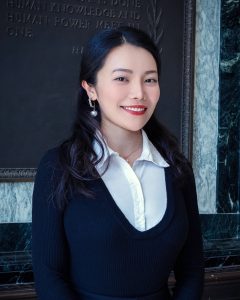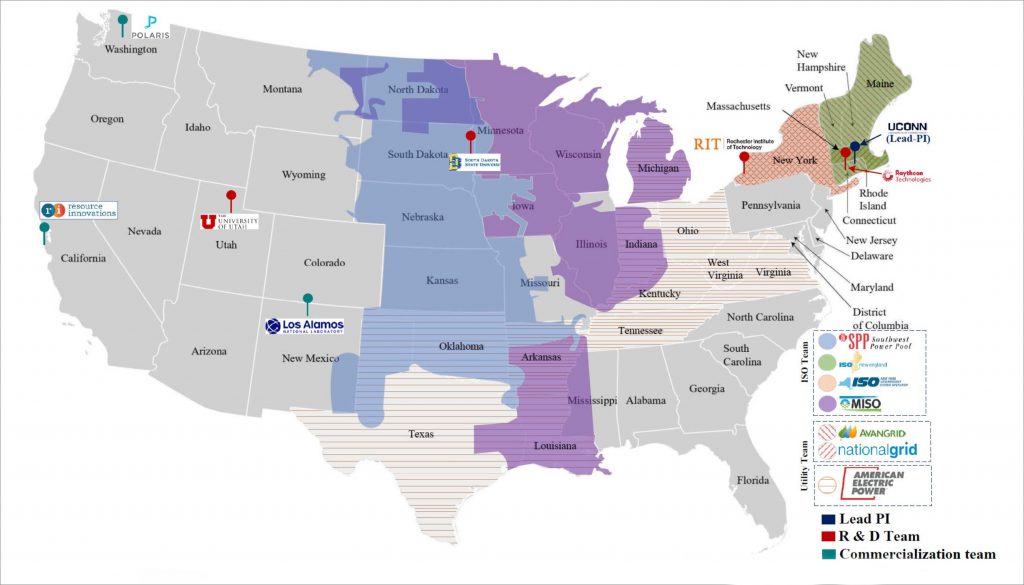A project spearheaded by the University of Connecticut will help power grid operators nationwide revolutionize how renewable energy sources are integrated into the electrical grid.
On March 19, the Department of Energy awarded Lead Principal Investigator, Associate Director of the Eversource Energy Center and Assistant Professor of Electrical Engineering Zongjie Wang with a $4.5 million grant ($3,340,168 DOE and $1,127,191 awardee costs share) to pursue this groundbreaking initiative, which focuses on developing a new “TRANSFORMATIVE” tool that will make significant improvements in power grid efficiency, reliability, and resilience to bounce back from disruptions, like severe weather events.

“In the United States, the amount of electricity generated from renewable energy sources to supply the electric grid is continuing to increase,” Wang says. “Simultaneously, more electric customers are installing rooftop solar and battery energy storage systems. The accelerating integration of these resources can present complex challenges, but also bring opportunities that TRANSFORMATIVE will harness for both managing and operating the electric grid.”
The grant is among 11 projects to receive $44 million in funding for tools to advance a clean, reliable electricity grid run on wind and solar energy. It also supports opportunities to streamline the interconnection of clean energy to the grid.
The Project’s Nitty-‘Grid’-y
An electrical grid consists of both a transmission and distribution system (T&D). Traditionally, the United States electrical grid is operated through the transmission system level where large power plants—such as natural gas and coal—work to meet the energy needs of all consumers. In the current structure, grid operations only have visibility to the boundary of the distribution system with the local electric utility.
TRANSFORMATIVE, an acronym that stands for “Transmission and Distribution Systems with Flexible and Optimal Coordination: Resilience, Modeling, and Technologies for a Variable Renewable Energy Source and Distributed Energy Resources-Integrated Adaptive Energy Grid,” showcases a strong and diverse collaboration among national research and development experts. This team includes experts from the University of Utah, South Dakota State University, Rochester Institute of Technology, and Raytheon Technologies Research Center, alongside strategic partnerships with Los Alamos National Laboratory, Southwest Power Pool, and Resource Innovations (former name Nexant). Ali Bazzi, associate professor of electrical engineering at UConn, is also co-PI on the project.
The goal of Wang’s project is to develop an open-source T&D coordination tool that integrates renewable energy output into existing operational software at grid operator control centers. These centers are known as independent system operators (ISOs). This innovative tool will be the first-of-its-kind to use data visualization to display information about variable renewable energy sources and distributed energy resources in electric grid control centers.
During the three-year project, the tool will be demonstrated on the operational training console for the Southwest Power Pool, which manages an electric grid of over 50 GW capacity. The initiative is set to conduct comprehensive simulations using real-world data from several regional grids, including five major ISOs—ISO New England, New York ISO, Southwest Power Pool, California ISO, and Midcontinent ISO—in collaboration with leading utility companies such as American Electric Power, National Grid, and Avangrid.
Collaboration is Key
A diverse advisory group, encompassing more than 15 stakeholders from government agencies, utility companies, and the energy sector, supports the project. Wang’s extensive network, formed during her first two years at UConn and her postdoctoral studies at Cornell University and through her involvement in the North American Power Symposium (NAPS), has been instrumental in assembling this team. Her leadership will continue to be highlighted as she brings NAPS to UConn in 2025 as the general chair.
“We have a very strong team and many of us have worked together previously on projects and proposals,” she says. “We span the entire country, but we all have an overall interest and research expertise in building sustainable energy and power systems.”
The team will work together for the next 36 months to develop advanced TRANSFORMATIVE tools and techniques to enable the effective use of energy resources in distribution systems to provide essential transmission-level services, optimize the grid operation to meet specific needs for ISOs. A key focus of the project is not only the technological advancements but also ensuring these innovations lead to tangible impacts in the energy sector. To this end, the team is launching a robust commercialization plan designed to facilitate the swift and widespread adoption of the TRANSFORMATIVE tool across ISO control centers in the United States. With an ambitious and aggressive strategy, the team is committed to integrating these solutions into grid operations within two years post-project, marking a significant step forward in enhancing grid reliability and efficiency on a national scale.
“Our goal is to create a smarter and more adaptive energy grid that can handle the increasing amount of renewable energy being generated, while also ensuring reliability and resilience in the face of challenges,” Wang says. “This work is critical in navigating the complexities of integrating renewable energy sources into the existing grid.”

The DOE’s Solar Energy Technologies Office (SETO) Operation and Planning Tools for Inverter-Based Resource Management and Availability for Future Power Systems (OPTIMA) grant is one of the most competitive funding opportunities released, with thousands of first-round applicants. TRANSFORMATIVE is among six recipients of the grant under the topic area Variability Management in Grid Operations.
Pamir Alpay, vice president for research, innovation, and entrepreneurship, lauds Wang’s contributions, focusing on the transformative potential of her research.
“Dr. Wang’s innovative approaches to developing T&D coordination tools are setting new standards in the field,” he says. “Her work significantly enhances our understanding of how to integrate distributed energy resources efficiently, bolstering UConn’s reputation as a hub for cutting-edge energy research. This project not only advances our academic prowess but also promises substantial benefits for our community and the global push towards sustainable energy solutions.”
Preparing for the Transformative Project
Wang, who joined the Electrical and Computer Engineering Department in Fall 2021, began writing this proposal during her second year at UConn. As one of only three women in the department, and one of only two women of color in the department, Wang’s achievements underscore her role as a trailblazer for women in engineering, particularly in the specialized areas of grid optimization and resilience.
Several faculty in the CoE recognized her efforts as a voice for inclusion in research, including Kazem Kazerounian, professor and dean of the College of Engineering; Anne D’Alleva, provost and vice president for academic affairs; and Emmanouil “Manos” Anagnostou, Board of Trustees Distinguished Professor and Eversource Energy Chair in Environmental Engineering—who recently promoted Wang to associate director of diversity, equity, and inclusion (DEI) and industry workforce development.
“Dr. Wang’s excitement and energy on supporting and engaging our underrepresented students in their research endeavors, and her strong commitment to workforce training will be instrumental to our center’s growth and success in DEI and workforce development,” Anagnostou says. He is also a UConn CoE Interim Associate Dean for Research and Industrial Partnerships.
“Being a female in the field of electrical engineering, especially in power systems, a discipline where women are significantly underrepresented, my journey and achievements carry an added layer of significance,” Wang says. “My presence and success symbolize a stride towards readdressing gender imbalances and serve as an inspiration and role model for aspiring female engineers.”



